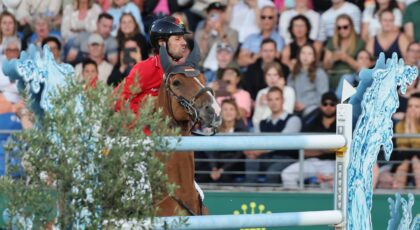One of the biggest annoyances for horse people is when a horse throws a shoe.
They always do it at the most inconvenient times—the morning you’re leaving for a show is a perennial favorite, or right at the start of the lesson you trailered over an hour to get to. While not all tossed shoes are avoidable, some are more likely to happen than others. Here are some ways to help prevent future footware mishaps:
1. Stepping on the heel with another hoof

If your horse is losing shoes while working, if he is prone to catching his front heels with his back hooves, or if you hear that telltale clicking sound of forging, both you and your farrier (and maybe your trainer) need to address the issue. Bell boots can help the occasional mishap, but taking a close look at how your horse moves and making some adjustments to his shoeing and training can also help. Your farrier may want to square off the toes more on the rear hooves, or tighten up the heels on the front shoes. You (or your trainer) should also be sure your horse is learning to carry himself like an athlete and not get too strung out or on the forehand, as an unbalanced horse is more likely to injure himself and pull a shoe.
2. Getting it stuck in the mud

©smerikal/Flickr CC by 2.0
Does your horse like to swim in the pasture pond? Does he wallow around in the swamp out back every time it rains? The combination of moisture constantly softening up the hoof wall and the sucking action of the mud can pull shoes right off. Have you ever lost a boot in a mudhole? It sucks (literally)! The best answer here is keep him out of the mud as much as possible.
3. Getting it hooked pawing (or kicking) at the fence

kaktuslampan/Flickr CC by 2.0
Wire fence is the usual culprit here, but boards can be a problem, too—especially if the horse can stick his foot through, hook the shoe, and pull it off. There is obviously more danger here than just a lost shoe. A horse that gets hung up can do a lot of damage to himself in a hurry if he panics (and we all know too well that horses are panickers by nature). Electric wire run on the inside of the existing fence can help keep horses away from it. If the fence is truly unsafe, though, you may need to invest in an upgrade.
4. Flinging it off

©Thowra_uk/Flickr CC by 2.0
This seems unlikely on the surface, except when the shoe is already loose, due to be reset, or the hoof is weak or damaged. Still, it’s not unheard of, especially with some more acrobatic horses. Keep your horse on a good hoof care schedule to help prevent this one, and always check for loose nails or damage before riding.
5. Crumbling hoof wall

©Tom Woodward/Flickr CC by 2.0
Not every horse is blessed with a good hoof, unfortunately. A good diet (and sometimes a hoof supplement) can help grow a stronger hoof for some horses. Topical treatments can help a little, too. You may also want to evaluate whether your horse could be a candidate to take a break from shoes for a while and let some of the damage grow out—or if he needs shoes at all.
6. Stomping on hard ground

©Harris Walker/Flickr CC by 2.0
If your horse spends most of the day stomping at flies, he can loosen up the clinches on his shoes and start tossing them. While playing horseshoes may be fun at a barbeque, it’s not fun when you have to put your trail ride on hold. Put some fly spray or fly gear on your horse, and keep the manure and mud cleaned up to help cut down on the fly population.
Taking some time to figure out how your horse is removing his shoes will make it much easier to prevent in the future. Remember, when it comes to horses doing damage to themselves or others, their belief is always, “Where there is a will, there is a way!” It is our job as horse owners to prevent them from self-destructing.
About the Author
Nancy Rich-Gutierrez is an IT professional and manages her husband’s farrier company. When she’s not busy with her full-time job or running the office for her farrier, she’s chasing their two-year-old and riding her Arabian horses. Check out the HG Horseshoeing blog at hghorseshoeing.com.

 February 23, 2017
February 23, 2017 

























